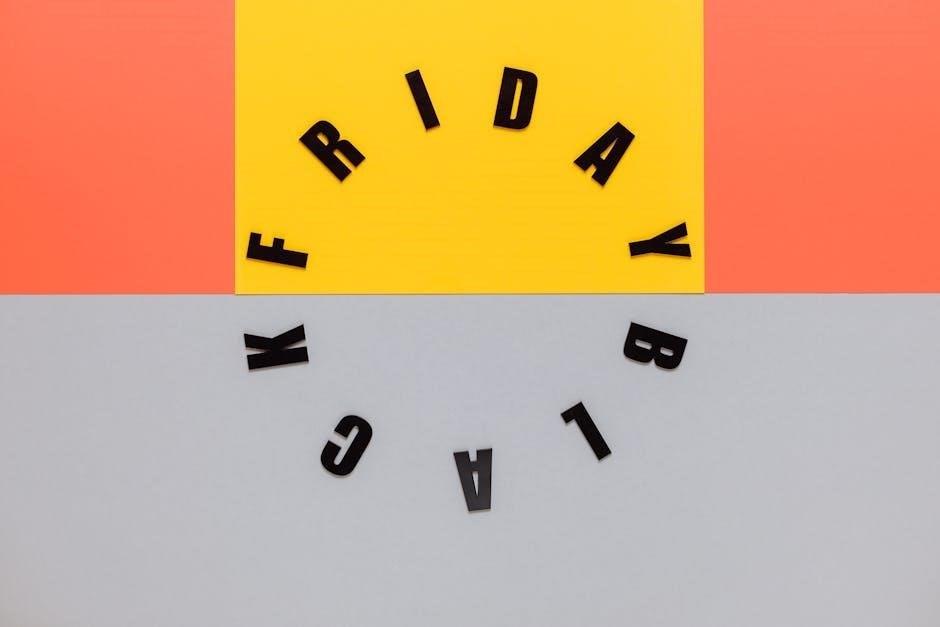Understanding graphic design pricing is crucial for both clients and designers. This guide provides a detailed breakdown of fees, factors influencing costs, and pricing models, ensuring transparency and clarity in graphic design services.
Importance of Understanding Graphic Design Fees
Understanding graphic design fees is essential for transparent budgeting and decision-making. It helps clients avoid overpayments and ensures designers are fairly compensated. A clear pricing structure allows both parties to align expectations, reducing misunderstandings. This guide provides insights into industry standards, enabling informed choices and fostering trust in the design process. Whether you’re a client or designer, knowing the value of services ensures quality and satisfaction in every project.
Overview of the Graphic Design Pricing Guide PDF
The Graphic Design Pricing Guide PDF offers a comprehensive breakdown of industry-standard fees for various design services. It covers over 110 services, including logo design, website graphics, and print materials, providing clear cost ranges. This guide is a valuable resource for both clients and designers, ensuring transparency and clarity in pricing. It also includes insights into factors influencing costs, such as experience level and project complexity, helping users make informed decisions.

Factors Influencing Graphic Design Pricing
Graphic design pricing is shaped by experience, project complexity, location, and deadlines. These factors determine the final cost, ensuring fair compensation for the designer’s expertise and effort.
Experience Level of the Designer
A designer’s experience significantly impacts pricing. Entry-level designers charge lower rates, typically between $25-$50 per hour, while mid-level professionals range from $75-$150. Experienced designers, with portfolios showcasing high-quality work, often charge $150-$300 or more. Their expertise ensures polished results, justifying higher fees. This tiered pricing reflects the value of skills honed over time, benefiting clients seeking tailored, professional designs.
Complexity of the Project
Project complexity greatly influences graphic design fees. Simple tasks like basic logo designs or social media graphics may cost between $50-$300. Moderately complex projects, such as branding packages or websites, range from $300-$2,000. Highly intricate designs, including custom illustrations or 3D animations, can exceed $3,000. The scope, detail, and time required drive these variations, ensuring clients pay fairly for the creativity and effort involved.
Geographic Location of the Designer
Geographic location significantly impacts graphic design fees. Designers in urban or high-cost areas often charge premium rates, while those in regions with lower living expenses may offer competitive pricing. For example, designers in North America or Europe may charge $100-$250 per hour, whereas those in other regions might charge $20-$75 per hour. This variation reflects local economic conditions, cost of living, and market demand, influencing overall project costs for clients.
Turnaround Time and Deadlines
Turnaround time and deadlines play a crucial role in determining graphic design fees. Rush projects often incur higher costs, with designers charging premium rates for tight deadlines. For instance, a logo design typically priced at $300 might cost $500 if completed within 24 hours. Designers may also offer tiered pricing based on urgency, with standard, expedited, and rush options. Clear communication about deadlines helps set realistic expectations and avoids additional fees for revisions or delays.

Common Graphic Design Pricing Models
Graphic design pricing models include hourly rates, project-based fees, and retainer agreements. Each offers flexibility, catering to specific project needs, budgets, and client preferences effectively.
Hourly Rate Pricing
Hourly rate pricing is a common model where designers charge clients based on the time spent on a project. Rates vary widely, from $25 to $150 per hour, depending on the designer’s experience and location. This model is ideal for projects with undefined scopes or requiring iterative adjustments. Clients pay only for the time invested, offering flexibility and transparency. Hourly pricing is popular among freelancers and agencies alike, ensuring accurate billing for the work completed;
Project-Based Pricing
Project-based pricing involves charging a fixed fee for a specific design project, agreed upon upfront. This model is popular for well-defined tasks like logo design or branding packages. Rates vary based on project complexity, with logos costing $200-$800 and visual identity design ranging from $100 to $3,000. This approach provides clients with clear budget expectations and ensures designers are fairly compensated for the scope of work. It’s ideal for projects with defined deliverables and timelines.
Retainer-Based Pricing
Retainer-based pricing involves a recurring monthly fee for ongoing graphic design services. This model is ideal for clients needing consistent support, such as regular social media graphics or brand updates. Fees typically range from $500 to $2,500 per month, depending on the scope and frequency of work. It offers clients budget predictability and priority access to design resources, while designers benefit from stable income and long-term partnerships. This arrangement is perfect for businesses with steady design needs.
Average Graphic Design Rates
Average graphic design rates vary widely, from $20 to several thousand dollars per project, depending on the designer’s experience, complexity, and scope of the work involved.
Hourly Rates for Graphic Designers
Hourly rates for graphic designers typically range from $25 to $150 per hour, depending on experience and project complexity. Entry-level designers may charge $25-$40, while mid-level designers range from $50-$100. Experienced designers, especially those with specialized skills, can charge upwards of $150. These rates reflect time spent on tasks, expertise, and location. Clients can estimate project costs by multiplying hourly rates by the estimated time required for completion.
Fixed Rates for Specific Projects
Fixed rates for graphic design projects vary based on the scope and complexity. For example, logo designs often range from $350 to $750, while branding and visual identity projects can cost between $1,000 and $3,000. Web design projects typically fall between $5,000 and $30,000, depending on the number of pages and features. These fixed rates provide clients with a clear upfront cost, eliminating the uncertainty of hourly billing and ensuring a defined budget for the project.
Retainer Fees for Ongoing Services
Retainer fees are ideal for clients requiring consistent graphic design support. These fees range from $500 to $2,500 per month, depending on the scope and frequency of services. Retainers often include a set number of hours, specific deliverables like logos, branding materials, or social media assets, and priority access to the designer. This model provides stability for businesses with ongoing design needs, ensuring a reliable and dedicated creative partner without the unpredictability of project-based costs.

Graphic Design Services and Their Costs
Graphic design services include logo creation, branding, web graphics, and print materials, with costs varying based on complexity, designer expertise, and project requirements.
Logo Design Pricing
Logo design pricing typically ranges from $200 to $800, depending on the designer’s experience and project complexity. Basic logos with minimal revisions cost less, while intricate designs requiring multiple concepts and refinements are pricier; Experienced designers charge higher rates, ensuring high-quality, unique designs. Clients receive vector and bitmap files, suitable for various uses. This investment provides a professional brand identity, essential for business growth and recognition.
Branding and Visual Identity Design Costs
Branding and visual identity design costs range from $100 to $3,000, depending on project scope and designer expertise. This includes style guides, color palettes, typography, and brand messaging. Basic packages cover essential elements, while advanced packages offer custom patterns and detailed documentation. The cost reflects the time spent on research, concept development, and revisions. A strong visual identity enhances brand recognition and marketing efforts, making it a valuable investment for business growth.
Web and UI/UX Design Fees
Web and UI/UX design fees vary significantly based on project complexity and designer expertise. Basic web design projects can cost between $5,000 and $30,000, while UI/UX design for apps or complex systems may range from $10,000 to $50,000 or more. Experienced designers charge higher rates due to the detailed wireframes, prototypes, and user research involved. Deliverables often include design files in multiple formats, ensuring compatibility with various platforms and devices.
Print Design Pricing (Flyers, Brochures, etc.)
Print design pricing varies depending on the type and complexity of the project. Flyers typically range from $50 to $150, while brochures can cost between $100 and $300. Business cards are generally more affordable, priced at $25 to $50. Costs may increase for larger quantities or intricate designs. Factors such as design complexity, color usage, and formatting requirements also influence the final price. Deliverables often include high-resolution PDF files ready for printing.
Infographic and Presentation Design Costs
Infographic and presentation design costs vary based on complexity and scope. Hourly rates for infographic designers average around $40, with projects ranging from $5 to over $250. Presentations, especially for business or academic use, can cost between $100 and $500 or more, depending on the number of slides and design elements. Detailed research, custom illustrations, and animations significantly increase costs. Final files are typically delivered in PDF, PowerPoint, or vector formats for versatility.

Freelance vs. Agency Pricing
Freelance graphic designers typically charge lower rates than agencies, offering flexibility for specific projects, while agencies provide comprehensive services and expertise for complex design needs.
Cost Differences Between Freelancers and Agencies
Freelancers typically charge lower rates than agencies, with hourly fees ranging from $25 to $150, depending on experience. Agencies, however, offer comprehensive services with pricing reflecting their overhead and expertise, often starting at $100 per hour or higher. While freelancers provide flexibility for specific projects, agencies deliver a broader range of services, including strategy and project management, justifying their higher costs.
Value-Added Services by Agencies
Agencies offer comprehensive solutions, including brand strategy, market research, and project management. These services enhance the design process, ensuring alignment with business goals. Agencies provide a team of experts, resulting in diverse skill sets and higher quality outcomes. Their structured approach often includes revisions and feedback loops, adding value beyond standalone design work. This holistic service justifies higher costs compared to freelance options.
Flexibility of Freelance Designers
Freelance designers offer adaptability, tailoring services to specific client needs. They often work on a project basis, allowing for customized pricing and timelines. Freelancers can adjust their workflows to meet unique requirements, providing personalized attention. This flexibility makes them ideal for small or specialized projects, offering cost-effective solutions without compromising quality. Their ability to scale up or down ensures clients receive exactly what they need, fostering long-term partnerships.

Pricing for Specialized Graphic Design Services
Specialized graphic design services, such as custom illustration and 3D design, often incur higher fees due to complexity and expertise required, varying widely based on project scope.
Custom Illustration and Icon Design Fees
Custom illustration and icon design fees vary widely based on complexity and detail. Basic icon sets may cost between $50 to $200, while intricate illustrations can range from $200 to $1,000 or more. Experienced designers charge hourly rates of $75 to $150, with projects requiring multiple revisions or high-resolution files commanding higher fees. These costs are outlined in detail in the graphic design pricing guide PDF, ensuring clarity for both clients and designers.
3D Design and Animation Pricing
3D design and animation pricing varies significantly based on project complexity and duration. Hourly rates range from $75 to $150, while project-based fees can start at $500 for simple animations and exceed $5,000 for intricate 3D models. Factors like the number of frames, textures, and render quality influence costs. Experienced designers may charge premiums for high-resolution outputs and detailed animations, as outlined in the graphic design pricing guide PDF.
Package Design Costs
Package design costs vary widely, ranging from $300 for basic layouts to $2,500 or more for complex designs. Factors like custom illustrations, 3D modeling, and branding integration influence pricing. Hourly rates for packaging design typically fall between $50 and $150. Project-based fees are common, with additional charges for revisions or specialty finishes. Detailed concepts and high-resolution files are often included, as outlined in the graphic design pricing guide PDF.
Print-Ready File Preparation Fees
Print-ready file preparation fees typically range from $50 to $300, depending on the complexity of the project. This includes converting designs into formats like PDF, AI, or PNG, ensuring proper resolution, and checking for print accuracy. Some designers charge hourly, while others offer flat rates. High-end projects with intricate details may incur higher costs, as detailed in the graphic design pricing guide PDF.
How to Determine Your Graphic Design Budget
Assess project requirements, set realistic budget ranges, and compare quotes from designers. The pricing guide PDF offers insights into average costs and tips for effective budget planning.
Assessing Your Project Requirements
Understanding your project scope, goals, and desired outcomes is essential for accurate budgeting. Identify the type of design needed, such as logo, branding, or web design, and consider complexity, deliverables, and timelines. Evaluate whether additional services like style guides or vector files are required. Research industry standards and compare quotes to align expectations with your budget. This step ensures clarity and helps avoid unexpected costs, making your project planning more efficient and effective.
Setting a Realistic Budget Range
Define your budget based on industry standards and project complexity. Research average costs for services like logo design ($200-$800) or web design ($5,000-$30,000). Consider the designer’s experience and location, as these impact pricing. Factor in additional costs for revisions or style guides. Aim for a range that balances quality and affordability, ensuring it aligns with your project goals and long-term needs for scalability and adaptability.
Comparing Quotes from Different Designers
When comparing quotes, review the scope of work, deliverables, and timelines. Ensure each designer provides a detailed breakdown of costs, including any additional fees for revisions or file formats. Consider the designer’s portfolio and experience, as these impact pricing. Consider the overall value, not just the cost, to find a balance between quality and affordability that meets your project needs and expectations.
Negotiating Graphic Design Prices
Negotiating graphic design prices involves discussing project scope, timelines, and deliverables to align costs with expectations, ensuring a fair deal for both parties.
Understanding the Designer’s Cost Structure
Understanding a designer’s cost structure involves recognizing factors like time, materials, expertise, and overheads. Designers often base fees on hourly rates, project complexity, and required revisions. They may also include costs for software, stock images, and additional tools. Transparency in pricing helps clients see the value behind the services, ensuring fair agreements and mutual satisfaction. This insight is key to effective negotiations and building trust in the design process.
Effective Communication for Better Rates
Clear communication is key to securing fair graphic design rates. Ensure your project brief is detailed, outlining objectives, timelines, and expectations. Regular updates and transparency help avoid scope creep. Ask questions to understand the designer’s process and costs. Open dialogue fosters trust, ensuring both parties align on deliverables and pricing, leading to a smoother collaboration and better outcomes for your design project.
Red Flags in Pricing Negotiations
Red flags in pricing negotiations include hidden fees, lack of transparency, and unrealistic rate demands. Be cautious if designers refuse to provide detailed breakdowns or seem evasive about their cost structure. Unwillingness to clarify terms or overpromising results without clear scope can signal unprofessional practices. Trust your instincts and seek alternatives if these signs arise, ensuring a fair and transparent agreement for your graphic design project.
Cost-Saving Tips for Graphic Design Projects
Clear communication and detailed briefs reduce revisions. Using templates and existing assets lowers costs. Phased payments and flexible terms can optimize your graphic design budget effectively.
Clear Briefs to Avoid Revisions
Clear communication is key to avoiding costly revisions. A well-structured brief ensures designers understand your vision, reducing misunderstandings. Include a detailed questionnaire about your brand identity, design preferences, and project goals. Specify required file formats and any existing assets. A comprehensive brief saves time and ensures the final product meets expectations, fostering a smooth design process.
Using Templates and Existing Assets
Using pre-designed templates and existing assets can significantly reduce costs. Templates for logos, brand guidelines, or social media designs streamline the process. Providing existing content, such as high-resolution images or brand fonts, ensures consistency and saves time. This approach minimizes the need for extensive customization, allowing designers to focus on refining rather than starting from scratch, ultimately lowering fees and accelerating project completion.
Phased Payment Structures
Phased payment structures allow clients to pay in installments, aligning payments with project milestones. This approach reduces upfront costs and ensures both parties are satisfied at each stage. Designers benefit from consistent cash flow, while clients can review and approve work before proceeding. This method promotes transparency, trust, and flexibility, making it a cost-effective solution for managing graphic design projects without financial strain.
ROI of Graphic Design Investments
Graphic design investments yield significant ROI through enhanced brand recognition, customer engagement, and sales growth. Quality designs drive long-term value, justifying initial costs and fostering business success.
Measuring the Impact of Graphic Design
Graphic design’s impact is measured through increased brand recognition, customer engagement, and sales growth. Key metrics include conversion rates, social media shares, and revenue uplift. Effective designs, like compelling logos and consistent visual identities, enhance user experience and drive business success. By aligning design with marketing goals, companies can quantify ROI and justify design investments, ensuring creative efforts yield tangible, measurable outcomes.
Long-Term Benefits of Quality Design
Quality design fosters brand loyalty and recognition, creating a lasting impression. Consistent visuals enhance credibility, while tailored designs resonate deeply with target audiences. By investing in professional graphic design, businesses build a strong foundation for growth, ensuring their brand stands out and endures. Over time, this leads to increased customer trust, market differentiation, and sustained business success, making quality design a valuable long-term asset;
Aligning Design with Business Goals
Effective graphic design aligns seamlessly with business objectives, driving brand identity and marketing strategies. By understanding a company’s mission and vision, designers create visuals that communicate core values, enhancing customer engagement and conversions. Tailored designs ensure consistency across platforms, reinforcing brand messaging and fostering trust. This strategic alignment not only elevates brand presence but also supports long-term business growth and profitability.
Graphic design pricing requires careful consideration of factors like experience, complexity, and models. This guide helps you make informed decisions and find value in quality design.
Final Thoughts on Graphic Design Pricing
Graphic design pricing varies widely based on factors like designer experience, project complexity, and location. This guide helps you navigate these costs, ensuring you find the right balance between quality and affordability. Whether you’re a client seeking services or a designer setting rates, understanding these dynamics is key to successful collaboration and achieving your design goals effectively.
Encouragement to Use the Pricing Guide PDF
Download our comprehensive graphic design pricing guide PDF to explore detailed fee structures, service costs, and industry standards. This resource is essential for clients seeking transparency and designers aiming to set competitive rates. It offers clear insights into pricing models, ensuring informed decisions and successful project outcomes for all parties involved in graphic design services.
